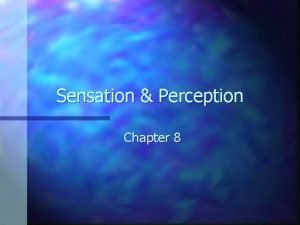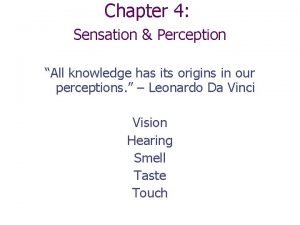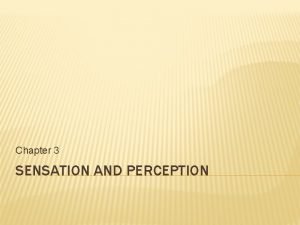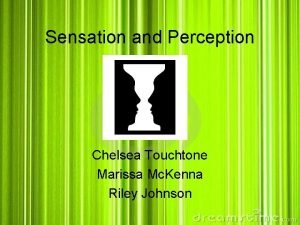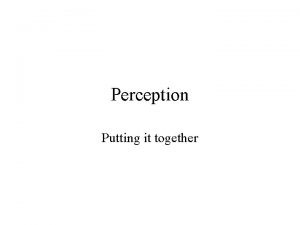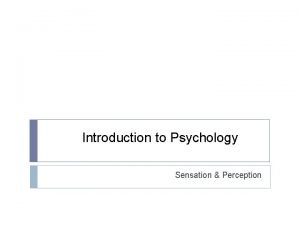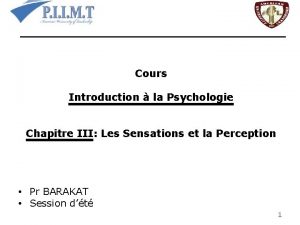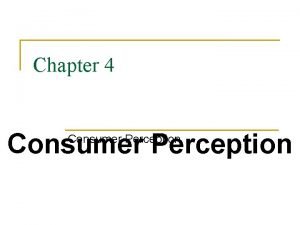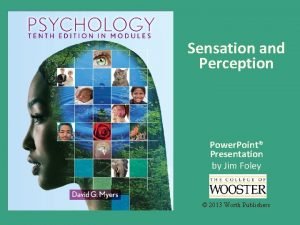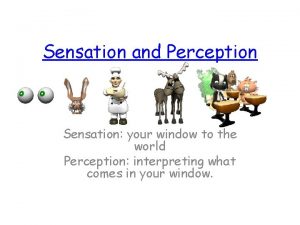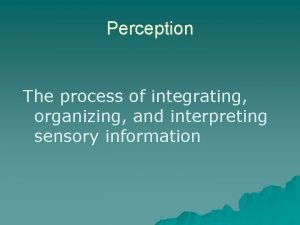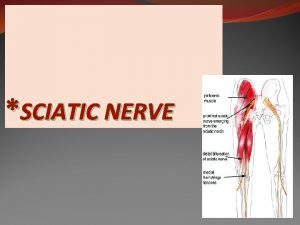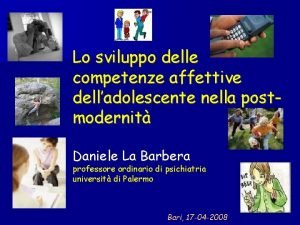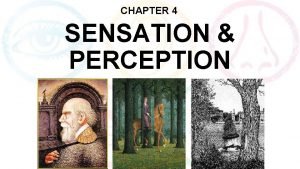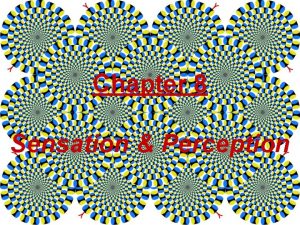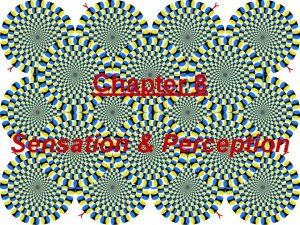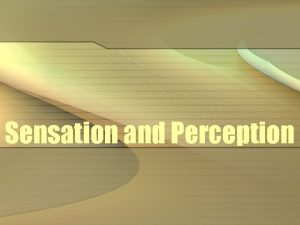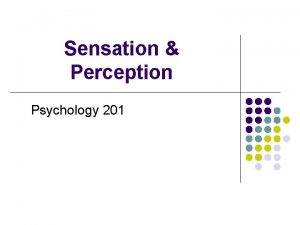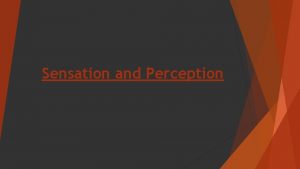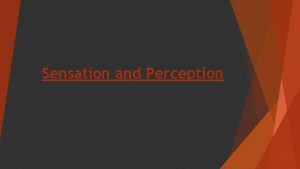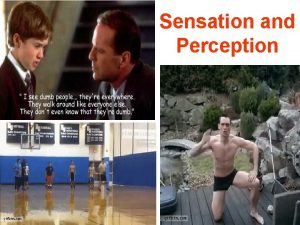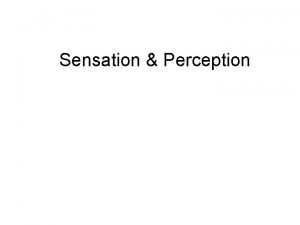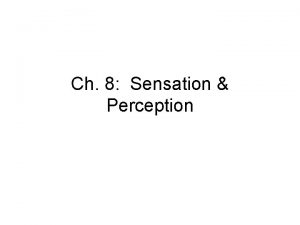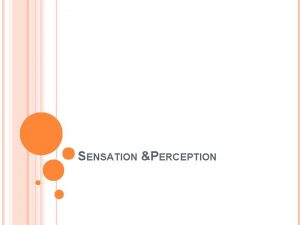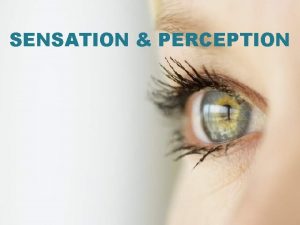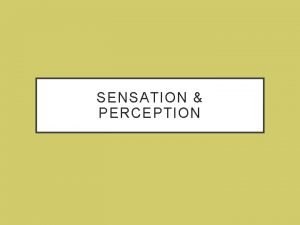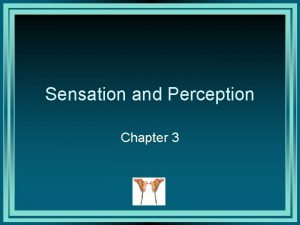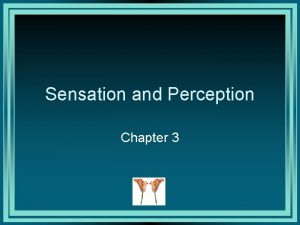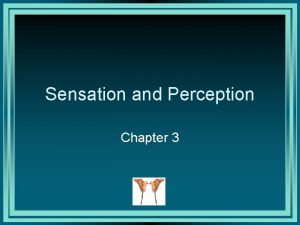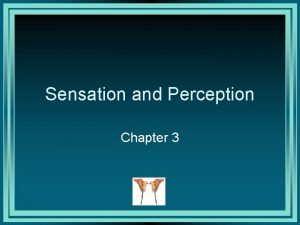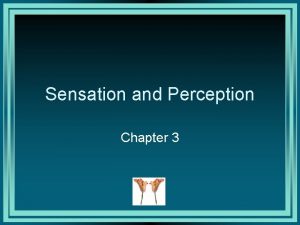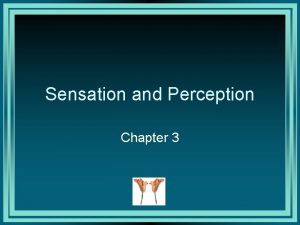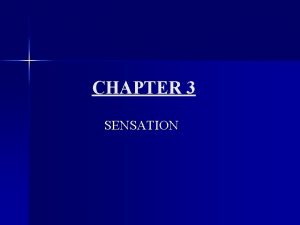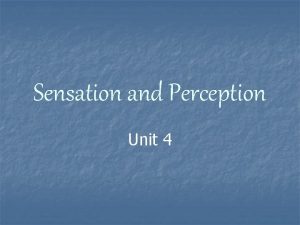Perception Chapter 4 Outline 1 From Sensation to
























- Slides: 24

Perception Chapter 4

Outline 1. From Sensation to Representation 1. 2. 3. 4. Basic Concepts Perceptual Constancies Depth Perception Gestalt Approaches to Form Perception 2. Theoretical Approaches to Perception 1. Bottom-Up Approaches 2. Top-Down Approaches 3. Deficits in Perception

1. From Sensation to Representation 1. Basic Concepts • Perception – The set of processes by which we recognize, organize, and make sense of the sensations we receive from environmental stimuli • Percept – Complex mental representation integrating particular sensational aspects of a figure

? Pick an example of a complex percept and identify the individual sensational aspects the percept consists of.

1. From Sensation to Representation • 1. Basic Concepts Perceptual experience involves four elements: – Distal (far) stimulus • – Informational medium • – Reflected light, sound waves, chemical molecules, or tactile information coming from the environment Proximal (near) stimulus • – The object in the external world Representation of the distal stimulus in sensory receptors (e. g. picture on the retina) Perceptual object • Mental representation of the distal stimulus

? Can you provide an example of perceptual processing of a particular object? Identify distal object, informational medium, proximal stimulus and perceptual object.

1. From Sensation to Representation 2. Perceptual Constancies • Perceptual constancy – Occurs when our perception of an object remains the same even when our proximal sensation of the distal object changes – Two cases of perceptual constancies: • Size constancy • Shape constancy

1. From Sensation to Representation 2. Perceptual Constancies • Size constancy – The perception that an object maintains the same size despite changes in the size of the proximal stimulation • The same object at two different distances projects different-sized images on the retina • Size constancy can be used to elicit illusions (e. g. Ponzo illusion or Müller-Lyer Illusion)

1. From Sensation to Representation 2. Perceptual Constancies • Shape constancy – The perception that an object maintains the same shape despite changes in the size of the proximal stimulus • Involves the perceived distance of different parts of the object from the observer

1. From Sensation to Representation 3. Depth Perception • Importance of depth perception – When you drive, you use depth to assess the distance of an approaching automobile – When you decide to call out to a friend walking down the street, you determine how loudly to call, based on how far away you perceive your friend to be

1. From Sensation to Representation • 3. Depth Perception Monocular depth cues – Represented in just two dimensions and observed with just one eye 1. Texture gradient - Larger grains, farther apart 2. Relative size - the closer the bigger 3. Interposition - closer object partially obscures other object; farther object is partially obscured by other object

1. From Sensation to Representation 3. Depth Perception • Monocular depth cues (cont. ) 4. Linear perspective - apparently parallel lines seem to converge as they approach the horizon 5. Aerial perspective - the closer the object the crisper images seem, more clearly delineated 6. Motion paralax - objects approaching get larger and move quickly closer

1. From Sensation to Representation • 3. Depth Perception Binocular depth cues 1. Binocular convergence - The closer the object you are trying to see, the more your eyes must turn inward Your muscles send messages to your brain regarding the degree to which your eyes are turning inward, and these messages are interpreted as cues indicating depth

1. From Sensation to Representation 3. Depth Perception • Binocular depth cues 2. Binocular Convergence - The closer an object is to you , the greater the disparity between the views of it as sensed in each of your eyes - The apparent jumping of images between the two eyes, which indicates the amount of binocular disparity, will decrease with distance

1. From Sensation to Representation 4. Gestalt Approaches to Form Perception • Structuralism vs. Gestalt Psychology – Structuralist approach to from perception is decompositional and thus focused on breaking wholes into elementary components – The goal of Gestalt psychology was to address directly the more global, holistic processes involved in perceiving structure in the environment

1. From Sensation to Representation 4. Gestalt Approaches to Form Perception • Gestalt principles – Figure-ground • When perceiving a visual field, some objects (figures) seem prominent, and other aspects of field recede into the background (ground) – Proximity • We tend to perceive objects that are close to each other as forming a group – Similarity • We tend to perceive objects that are similar to each other as forming a group

1. From Sensation to Representation 4. Gestalt Approaches to Form Perception • Gestalt principles (cont. ) – Continuity • We tend to perceive smoothly flowing or continuous forms rather than disrupted of discontinuous ones – Closure • we tend to perceptually close up, or complete, objects that are not, in fact, complete

? Which Gestalt principles are applied in this display? +O+O+O+O +O+O

? Which Gestalt principles are applied in this display?

2. Theoretical Approaches to Perception 1. Bottom-Up Approaches - Start from the bottom, considering physical stimuli being perceived and then work their way up to higher-order cognitive processes (organizing principles and concepts) - Higher cognitive processes can not directly influence processing at lower levels

2. Theoretical Approaches to Perception 1. Bottom-Up Approaches • Gibson’s Theory of direct perception – The array of information in our sensory receptors, including sensory context, is all we need to perceive anything – We do not need higher cognitive processes or anything else to mediate between our sensory experiences and our perceptions – Existing beliefs or higher-level inferential thought processes are not necessary for perception

2. Theoretical Approaches to Perception • 2. Top-Down Approaches The perceiver builds (constructs) a cognitive understanding (perception) of a stimulus, using sensory information as the foundation for the structure but also using other sources of information to build the perception

2. Theoretical Approaches to Perception 2. Top-Down Approaches • Constructive Perception (Jerome Bruner) – During perception we quickly form and test various hypotheses regarding percepts based on • • What we sense (sensory data) What we know (knowledge stored in memory) What we can infer (using thinking) What we expect

3. Deficits in Perception • Visual Agnosia – People with visual agnosia have normal sensations of what is in front of them, but they cannot recognize what they see • Prosopagnosia – Severely impaired ability to recognize human faces
 Chapter 5 sensation and perception
Chapter 5 sensation and perception Chapter 3 sensation and perception
Chapter 3 sensation and perception Chapter 6 sensation and perception
Chapter 6 sensation and perception Psychology chapter 4 sensation and perception
Psychology chapter 4 sensation and perception Five basic tastes
Five basic tastes Sensation perception
Sensation perception Chapter 4 sensation and perception
Chapter 4 sensation and perception Chapter 3 sensation and perception
Chapter 3 sensation and perception Law of pragnanz
Law of pragnanz Ap psych sensation and perception
Ap psych sensation and perception Sensation example
Sensation example Perception
Perception Sensation vs perception
Sensation vs perception Sensation and perception
Sensation and perception Cours sur la perception en psychologie
Cours sur la perception en psychologie Sensation and perception in marketing
Sensation and perception in marketing Perception vs sensation
Perception vs sensation Sensation and perception
Sensation and perception Sensation and perception
Sensation and perception Sensation vs perception
Sensation vs perception Sensation and perception uu
Sensation and perception uu Sentence outline
Sentence outline Sensation seeking
Sensation seeking Sciatic sensory distribution
Sciatic sensory distribution Sensation seeking significato
Sensation seeking significato





